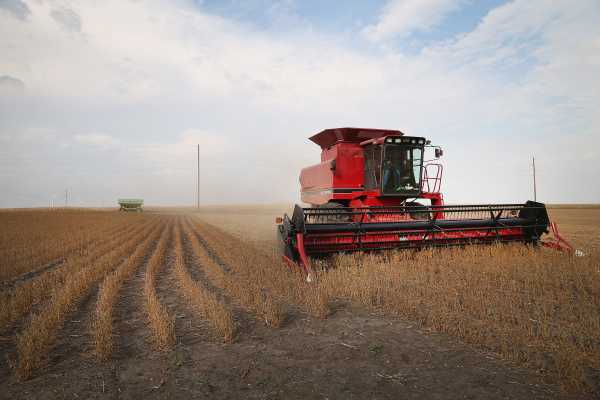
President Donald Trump’s trade war with China is making life harder for struggling American farmers.
A total of 84 farms in the upper Midwest filed for bankruptcy between July 2017 and June 2018, according to the Minneapolis Star Tribune. That’s more than double the number of Chapter 12 filings during the same period in 2013 and 2014 in Wisconsin, Minnesota, North Dakota, South Dakota, and Montana.
Farms that produce corn, soybeans, milk, and beef were suffering due to low global demand and low prices, according to economists, and Trump’s trade war is making the problem even worse. China has slapped billions of dollars worth of tariffs on US agriculture exports in response to Trump’s tariffs on Chinese products. Other countries, including Canada, have also added duties to US agriculture products in response to Trump’s tariffs on all imported steel and aluminum.
The problem has gotten so bad that the Trump administration launched a $12 billion aid package for US farmers coping with retaliatory tariffs that foreign countries have imposed on their products. In September, the government cut $25 million worth of bailout checks to the agriculture industry.
But even the bailout may not be enough to keep farms open. Bankers in the Midwest are worried that too many farmers are falling behind on loan payments.
“We’re just waiting for a turnaround,” one Minnesota banker told the Star Tribune. “We’re waiting for the tariff problem to go away.”
It doesn’t seem like the Trump administration is going to let that happen anytime soon.
Trump’s tariffs on Chinese imports hurt American businesses
Over the past year, the US has placed about $200 billion in tariffs on Chinese goods, in part to make Chinese products more expensive so Americans don’t buy them. The administration has also placed steep tariffs on all imported steel, angering other major US trade partners.
The idea was to level out the trade deficit and make China buy more US goods, but, as expected, China responded by slapping its own tariffs on American imports. And Trump’s steep tariffs on all imported steel and aluminum, which went into effect in March, have led other US trading partners to add their own retaliatory duties on American goods, including dairy, pork, apples, and potatoes.
As Vox’s Tara Golshan explains, the impact on the US agricultural industry is no joke. Prices for agricultural products like soybeans have dropped to a 10-year low since Trump imposed sweeping tariffs on Chinese goods earlier this year. And farmers across different markets have grown increasingly nervous about how their businesses will fare if the trade war continues.
That’s when Trump proposed the idea of a government program to stabilize the agriculture industry in three ways: by giving farmers direct cash assistance, buying surplus crops and giving them to food banks, and a vague trade promotion program.
The stabilization package will use a Depression-era program that allows the government to borrow up to $30 billion from the Treasury without congressional approval, according to the Washington Post. In September, the Agriculture Department sent farmers $25.8 million in aid. But even if the bailout does keep some farms open, it doesn’t address the fact that Trump’s trade policies just aren’t working.
The trade war hasn’t reduced the trade deficit with China
Trump has repeatedly stated that most of his trade policies are meant to target China, which sells more goods to the United States than it buys from the country.
But as Vox’s Alex Ward points out, the US has a lot more to be angry about:
Trump’s strategy has focused on efforts to cripple the Chinese economy at all costs, while disregarding the impact on the US economy. That includes placing tariffs on more than $200 billion worth of Chinese goods in the past year, which makes Chinese products more expensive — and therefore less appealing — to American consumers and businesses.
But Beijing has responded with its own tariffs on American goods, and the country has stopped buying as much from US manufacturers. So the trade imbalance between both countries is now worse.
In September, America’s trade deficit with China reached a new high: $34.1 billion. That’s a 13 percent increase compared to last year. Ford, America’s second-largest car company, said in August that Trump’s tariffs cost the company $1 billion, and the company now expects massive layoffs. On Monday, GM made a similar announcement.
This impact of Trump’s trade policies is striking, considering how often he repeated that his goal is to boost US manufacturing. His trade war might help the small US steel industry, but it’s hurting nearly every other sector of the US economy. And now taxpayers are stuck with the bill of Trump’s $12 billion bailout.
Sourse: vox.com






